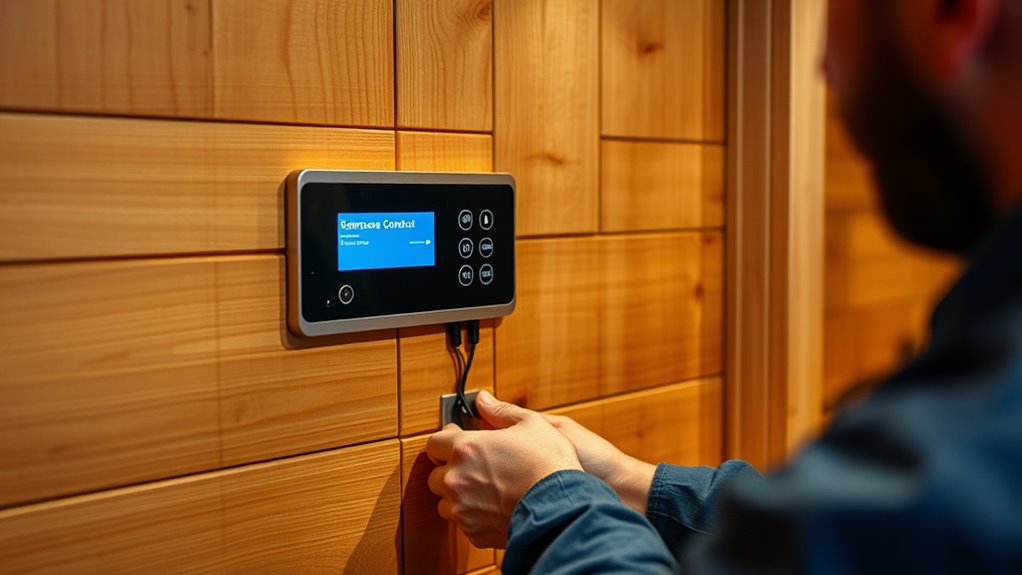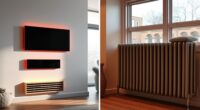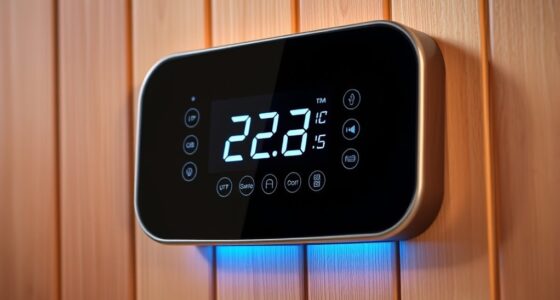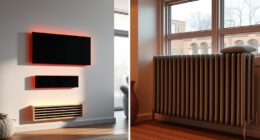To install a remote-control system for your sauna heater, first verify that the thermostat is compatible with remote systems and follow the manufacturer’s wiring instructions carefully. Turn off power before wiring, use insulated connections, and make certain of proper placement of the receiver in a dry, accessible spot. Double-check all connections, switch the power back on, and test the system for proper operation. Continuing will guide you through detailed steps to ensure safe and effective setup.
Key Takeaways
- Verify that the sauna heater thermostat is compatible with the remote control system according to manufacturer specifications.
- Turn off power and follow proper wiring procedures, using insulated connections and appropriate gauge wire.
- Choose a dry, accessible location for the remote receiver, avoiding moisture and extreme temperatures.
- Carefully connect all terminals, double-check wiring, then restore power and test remote functions thoroughly.
- Regularly inspect connections and maintain the system to ensure safety, reliability, and compliance with electrical codes.

Installing a remote-control system for your sauna heater can considerably enhance your relaxation experience by allowing you to adjust temperature and settings from a distance. This upgrade offers convenience, letting you start or modify your sauna session without leaving your seat or even getting up. To guarantee a smooth installation, you need to pay close attention to thermostat compatibility. Not all sauna heaters are designed to work with remote controls, so verifying that your heater’s thermostat is compatible is essential. Check the manufacturer’s specifications or consult with a professional to confirm that your model supports remote operation. Using incompatible thermostats can lead to malfunction or even damage to your equipment.
Once you’ve confirmed compatibility, wiring safety becomes your next priority. Installing a remote-control system involves electrical connections that, if done improperly, could pose safety hazards or cause operational issues. Before starting, turn off power to your sauna heater at the breaker box. Follow the wiring instructions provided with your remote system meticulously, ensuring all connections are secure and insulated. Use appropriate gauge wire and connectors rated for the electrical load to prevent overheating or shorts. If you’re uncomfortable with electrical work, hiring a licensed electrician is the safest choice. Proper wiring safety not only prevents accidents but also ensures your remote system functions reliably over time.
During installation, pay attention to the placement of the remote receiver. It should be installed in a dry, accessible location that’s shielded from moisture and extreme temperatures. Proper placement guarantees that signals are transmitted clearly and without interruption. When connecting the remote control to the heater, double-check that all terminals are correctly matched and tightened. Loose or incorrect connections can cause inconsistent operation or damage the system. Also, ensure your wiring adheres to local electrical codes, which might involve using specific conduit or protective coverings for outdoor or damp environments.
After completing the wiring, turn the power back on and test the remote system thoroughly. Verify that you can adjust the temperature and settings remotely without issues. If something doesn’t work as expected, double-check the wiring connections and thermostat compatibility. Regularly inspect the wiring and connections over time for signs of wear or corrosion, especially if your sauna is outdoors or in a humid environment. Incorporating proper project planning and following electrical safety standards can significantly improve installation success. Proper installation and maintenance not only maximize the convenience of your remote control system but also keep your sauna safe and reliable for years to come.
Frequently Asked Questions
Can I Retrofit My Existing Sauna Heater With a Remote Control?
Yes, you can retrofit your existing sauna heater with a remote control, but it depends on heater compatibility. Check if your heater supports retrofit options and is compatible with remote control systems. Some models may require specific accessories or upgrades. Consult your heater’s manufacturer or a professional installer to guarantee proper integration. This way, you can enjoy the convenience of remote operation without replacing your entire heater.
What Safety Features Are Included in Remote Control Systems?
Remote control systems include safety features like safety protocols that prevent accidental activation or overheating, ensuring your sauna’s safe operation. They also use system encryption to protect your control signals from hacking or unauthorized access. These features help you enjoy your sauna safely while giving you convenient remote management. Always choose a system with strong safety protocols and encryption to keep both your sauna and your household secure.
Is Professional Installation Required for the Remote Control System?
Think of installing your remote-control system as crafting a delicate symphony—precision matters. While DIY installation might seem tempting, it’s best to have a professional handle it to guarantee everything harmonizes perfectly. This not only guarantees safety and proper function but also preserves your warranty, which could be voided by amateur mistakes. Trust an expert to hit all the right notes, keeping your sauna experience smooth and worry-free.
How Does Weather Affect the Remote-Control System’s Performance?
Weather can impact your remote-control system’s performance through signal interference, especially during storms or heavy rain. Moisture resistance is essential; if your device isn’t properly protected against humidity or water ingress, it might malfunction. Make certain your remote system is rated for outdoor use and keep the receiver dry and shielded from extreme weather to maintain reliable operation, regardless of weather conditions.
What Is the Typical Lifespan of a Remote-Control System for Sauna Heaters?
Your remote-control system for your sauna heater typically lasts around 5 to 10 years, depending on product durability. Regular use and exposure to humidity can impact its lifespan. Investing in a high-quality system may reduce replacement costs over time. To guarantee longevity, keep the remote protected from moisture and extreme temperatures, and follow the manufacturer’s maintenance recommendations. Proper care helps maximize your system’s lifespan and saves you money.
Conclusion
By installing a remote-control system for your sauna heater, you gain convenience, comfort, and control. You’ll enjoy easy adjustments, effortless monitoring, and personalized settings. You’ll experience a safer sauna session, a more enjoyable routine, and greater energy efficiency. Embrace the ease of remote operation, the flexibility of customized temperatures, and the peace of mind knowing you’re in control. Upgrade your sauna experience today, and transform relaxation into a seamless, satisfying ritual.









